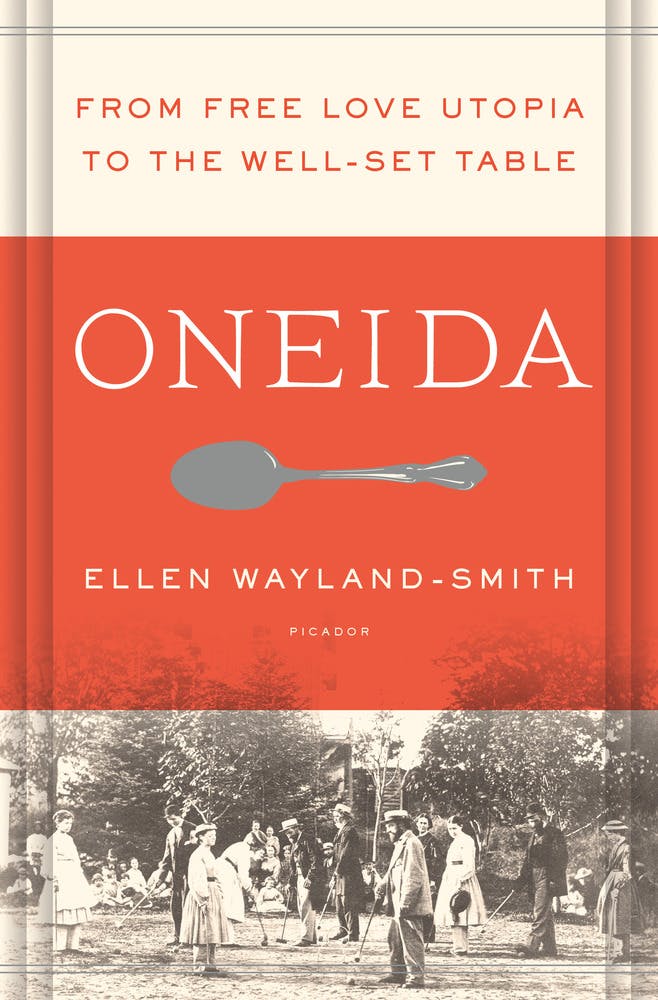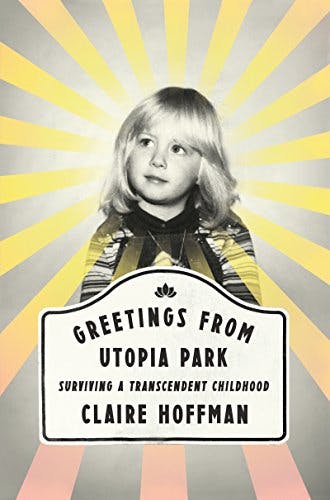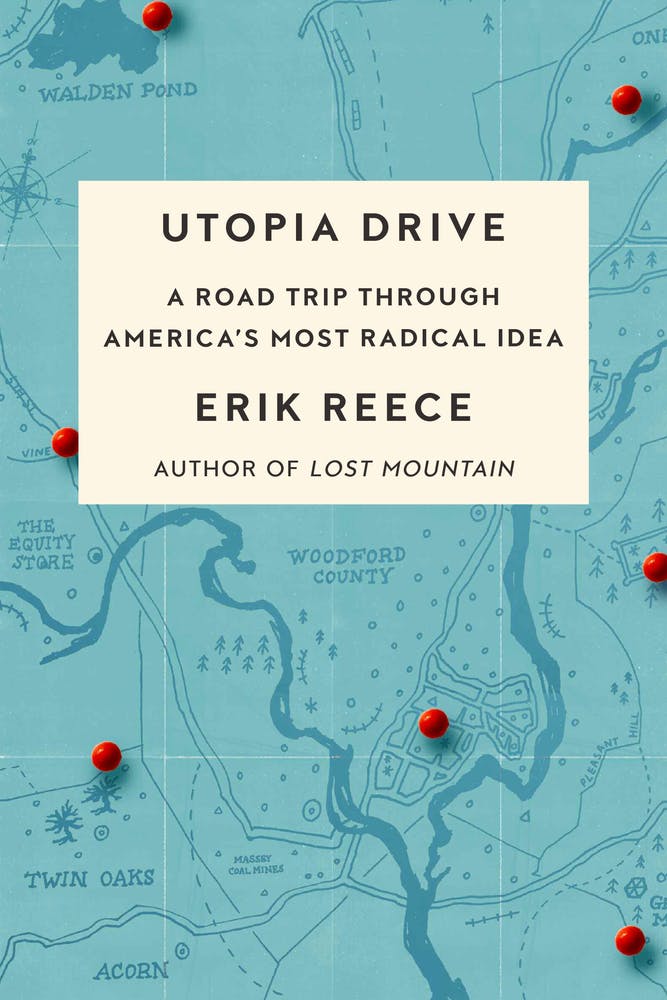In 1843, ten-year-old Louisa May Alcott packed everything she owned into a horse cart and set off for utopia, a “serene and sequestered dell,” near Harvard, Massachusetts, where Bronson Alcott, his wife and children, and a few volunteers would “prosecute our effort to initiate a Family in harmony with the primitive instincts in man.” The group would live and work communally, producing its own food and clothes. Its self-sufficiency would be a rebuke to the society’s dependence on slavery; the group would neither eat animals, partake in animal products, nor rely on their labor. In honor of their meat- and dairy-free diet, they named their new utopia Fruitlands.
In Transcendental Wild Oats, Louisa May Alcott’s lightly fictionalized account of her father’s experiment, she describes their arrival: “The wind whistled over the bleak hills; the rain fell in a despondent drizzle, and twilight began to fall. But the calm man gazed tranquilly into the fog as if he beheld a radiant bow of promise spanning the gray sky. The cheery woman tried to cover everyone but herself with [a] big umbrella.” The group, which would eventually include ten adults and five young children, spent their first evening perched on blocks of wood in a bare room—the furniture had yet to arrive—sharing a simple meal of potatoes, brown bread, and water: “Having cast the forms and vanities of a depraved world behind them, the elders welcomed hardship with the enthusiasm of new pioneers, and the children heartily enjoyed this foretaste of what they believed was to be a sort of perpetual picnic.” “Thus,” Alcott writes, “these modern pilgrims journeyed hopefully out of the old world, to found a new one in the wilderness.”
It takes a particular brand of American confidence to announce that we can and must improve the world in whatever way we see fit—and a particular American advantage to have access to land where an experimental household can exist well out of view of the neighbors. If the society’s problems feel too intractable, the pattern goes, it’s not only possible but necessary to start life anew.
Like the residents of Fruitlands, most people who sought out utopia over the last two hundred years were white, well-educated, and from relatively comfortable backgrounds. Some were students or scholars, others had rejected assured but unfulfilling fates as housewives, teachers, or businessmen. What they had in common was the fear of an imperiled, airless future in their comfortable society; and the belief it was up to them to invent an alternative. While some utopian groups endured lean years, many began their projects with enough capital and entrepreneurial resources to quickly establish their new lives. They were people whose privilege made them confident enough within society to be able to reject it without risking permanent destitution. The intellectual and personal freedom afforded by their own experience was earnestly applied to imagining a world that would make life better for everyone. But as three new books on the history of American utopianism show, privilege and utopia go hand in hand. Establishing a perfect world, ostensibly for all, still depended in large part on what “perfect” meant to those in charge. The rest must make do in their imperfect world.
In America, the quest for utopia goes through periodic surges. Fruitlands was one among scores of communitarian experiments that sprang up in the 1840s; a little over a century later, the numbers skyrocketed again, this time to the thousands, in the 1970s. In both eras, utopians sought fairness in work and love; a definition of family that extended beyond the nuclear structure; and an expanded personal freedom achieved through a greater codependence on the like-minded community.
The very nature of utopian living—experiment-as-critique—offers a window into culture and counterculture in one. The insistence among nineteenth-century groups on dignified labor and workdays that allowed individuals time for study and reflection reflected an anxiety about the dehumanizing effects of the Industrial Revolution. For the young communards of the ‘70s, the emphasis on extreme austerity and the preoccupation with freedom and self-expression revealed starkly how cluttered and stifling 1950s middle-class culture had felt to its children.
But this wholesale rejection of the previous generation’s values held dangers of its own. Radically altering the structure of family life, it turned out, did not automatically erase deeply-held assumptions about how daily work should be done and by whom. Many groups learned the hard way that abandoning society at large didn’t mean you weren’t doomed to replicate its failures in miniature.
In her fascinating, beautifully-told history published earlier this year, Oneida: From Free Love Utopia to the Well-Set Table, Ellen Wayland-Smith, herself a direct descendant of one of the Oneida community’s founding families, traces the story of the famous flatware company back to its origins as one of America’s most famous—and by many measures, most successful—utopian experiments in communal living. Founded by a splinter group of Christian Perfectionists, the original Oneida community lasted three decades. At its peak in the 1870s had several hundred members living in the red-brick 93,000-square foot Mansion House which still stands today in Oneida, New York and where Wayland-Smith’s parents still reside.

Between 1825 and 1840, a tremendous wave of Christian revivalism swept through the country, introducing an ecstatic form of worship that included practices like speaking in tongues and spontaneous conversion. (The area in Western New York where the Oneidans settled was such a hotbed for this religious fervor, including Joseph Smith and his Mormonism, that it became known as the “Burned Over District”). The religious rhetoric of the Second Great Awakening was rife with metaphors urging a more intimate relationship with the savior, and Oneida’s founder, John Humphrey Noyes, had a problem: He was both deeply religious and sexually frustrated. Noyes worked to reconcile his super-charged libido with a Christian faith that condemned all expressions of sexuality outside of the conjugal and procreative. The compromise he found seems as shocking now as it did in 1846—that the truest expression of Christian love should be through “amative” sex-for-pleasure, made sustainable by rigorous adherence to the birth control method he called “male continence.”
He soon found a handful of others to join him in this belief that the genitals were “the best and highest medium for union with God.” Noyes proclaimed that Oneidans would practice a form of “free love” called complex marriage, in which monogamy was expressly forbidden, and all members of the community were expected, and sometimes required, to be sexually available to one another. The practice offered its adherents an alternative to strictly-enforced monogamy and a theology that remained firmly Christian but interpreted sexual pleasure, not as sin, but as joyful worship.
Who doesn’t want a more satisfying sex life and a healthier work-life balance? For women, however, the benefits of utopia were rarely without consequences. The Oneida community’s early rhetoric borrowed heavily from the language of their contemporary, antebellum progressive movements, arguing that marriage and childbirth inherently “enslaved” women and that participation in complex marriage would set them free. Wayland-Smith notes that life in Oneida’s communal house had some real advantages for its women, particularly for those who wrote for and edited the group’s newsletter, and for those enjoying a robust sex life with men committed to effective birth control. But Noyes’s theology remained firmly patriarchal. The spirit of communal egalitarianism that, in the early days at least, found women at work in the shop and men cheerfully aiding with laundry, did not extend to the working-class women the more affluent group eventually hired to take care of domestic tasks.
At Fruitlands, the division of domestic labor was even simpler: Abigail Alcott did pretty much everything. In addition to the cooking, cleaning, and childcare, her daughter noted wryly, Abigail performed “the many tasks left undone by the brethren, who were so busy discussing and defining great duties that they forgot to perform the small ones.” In one instance, this included her bringing in an entire field of grain—the group’s only successful crop—aided only by the children. The men had all left on errands of their own. Several, predicting a long, hungry winter, never came back. By Christmas, only Bronson remained.
When I first read Alcott’s account as part of my background research for a book on back-to-the-land utopian experiments of the late 20th century, I actually gasped out loud. Almost the exact same thing had happened at Myrtle Hill, the Vermont commune I was chronicling, but in 1970. The similarities were almost eerie.
While the Pill had solved a major problem of free love for twentieth-century utopians, other issues remained surprisingly intractable. Some ‘70s communes instituted policies to ensure a fair division of labor, but groups without these quickly found that “smashing monogamy” and casting off the nuclear family had not prevented them from unconsciously recreating their parents’ unwelcome gender dynamics. As one woman put it in the pages of Utopia magazine, “Instead of suffering the miseries of shitwork and alcoholic husbands all alone in the house in the suburbs, [we] were together doing the shitwork as a group.” For many, including the women of Myrtle Hill, the feminist consciousness of the early ‘70s arrived into their communal lives like a thunderbolt. Many groups could not survive the adjustments it required.
But for the women I interviewed—as, Wayland-Smith emphasizes, for the women of Oneida—the joys and disappointments of communitarian life just as often came down to individual experience. For some mothers, Oneida’s policy of housing and raising the group’s children communally offered a cherished freedom from full-time childcare; for others, the separation was pure torture. In both eras, free love brought bliss and heartbreak to men and women alike.
And too: though the invisibility of women’s work often meant that the reality of their experience went ignored and unconsidered, the central appeal of utopia for women, no less than for men, was the fervent belief that a better future, for themselves and for the world, was within their power to create.
In 1982, when Claire Hoffman was five years old, her mother, Liz, told her and her brother that they were moving from New York City to rural Iowa. Hoffman’s father, an alcoholic writer, had recently abandoned the family; Liz was hoping for a new start and a deeper connection with the community and spiritual practice that promised relief from the ghosts of her own traumatic childhood. Fairfield, Iowa was the home of Heaven on Earth, the national headquarters for Maharishi Mahesh Yogi, the man who developed and popularized Transcendental Meditation. His followers believed that by meditating for hours a day, focused on a specific, personal mantra, it would be possible to achieve Enlightenment, a state Hoffman’s mother described to her as “when you were unconditionally happy and nature supported you and the universe gave you everything you wanted.”

In his 1976 article, “The Me Decade and the Third Great Awakening,” Tom Wolfe pointed out that, like the Christian revivals that gave rise to the earlier utopian explosion, the ‘70s movement also began “in a flood of ecstasy, achieved through LSD and other psychedelics, orgy, dancing (the New Sufi and the Hare Krishna), meditation, and psychic frenzy (the marathon encounter).” Hoffman’s memoir, Greetings from Utopia Park: Surviving a Transcendent Childhood, is a smart, engrossing coming-of-age story set in a community in which the pastel-clad adults organized their work and family lives around their group meditation practices and personal quests for Enlightenment, while their teenagers slipped out at night, headed for alcohol and meth-fueled parties in the Iowa cornfields. But the community had loftier goals as well—nothing short of World Peace, which the Maharishi explained would be brought about by thousands of people all meditating at once.
In scene after beautifully-told scene, Hoffman exposes one of the key ironies in the actual experience of utopia—while parents attempt to create a perfect world designed specifically to contrast the problems of their own upbringings, very few of their children actually grow up entirely within that bubble. Hoffman recounts the lesson she received from a fellow outsider on her first day at her Iowa public school:
“Are you a ‘ru?’ Ananda asked.
‘A what?’
‘A ‘ru, a guru. A meditator?’
‘Yeah,’ I said, my eyes flicking over the tables where the rest of the kids were sitting…
Ananda was already looking away from me, moving back toward the rest of the kids. ‘Don’t tell anyone that,’ she said softly.
And then I was alone.”
For Hoffman, this social exile ends when an admirer of her mother’s begins paying her tuition at the private Maharishi School. But entry into the heart of the community only exposes its own, more devastating divisions. Ever perceptive, Hoffman soon notices that, in contrast to her own struggling single mom, the wealthy “had time to meditate for hours a day, doing the extra ‘rounds’ of meditation that accelerated spiritual Enlightenment.”
Hoffman, a journalist, includes thoughtful context on the organization, including former members’ accusations against the Maharishi for financial malfeasance. But even in her most clear-eyed critiques of the community’s shortcomings, Hoffman never mocks her mother’s desire for the better, purer, simpler happiness promised by Enlightenment.
“When I was twelve years old I figured out that Utopia didn’t exist,” Hoffman writes. “But the quest for personal fulfillment—call it enlightenment, twenty-four-hour bliss, satisfaction, inner peace—that was much harder to relinquish.” She understands how, despite the Maharishi’s logic-defying claims and broken promises, people like her mother might choose to be part of a movement larger than themselves, to partake in an idealism that lets you feel like you and your friends have hit upon the perfect solution to all the world’s ills.
The promise and the problem of utopia are bound up together in one simple phrase: How should people live? In Utopia Drive: A Road Trip Through America’s Most Radical Idea, Erik Reece sets a course through a handful of American utopias, past and present, on a quest to address exactly this question. An environmental journalist, here Reece locates himself firmly in the tradition of the well-read seeker-philosopher. He takes leave of his new wife and cozy home for a solo journey undertaken in the hope that this pilgrimage might alleviate some of the anxieties he shares with many Americans—about global warming and rampant economic inequality and the sense of “being swept into the future by forces we believe are beyond our control, too powerful to be stopped.” For Reece, the mission of this road trip is “an attempt to retrieve this country’s utopian past, along with the possibility of a radically different future.”

As he charts a route around the eastern US, he stops in at former utopias, now mostly reduced to museums and guest houses or even uninhabited landmarks: the former Shaker village of Pleasant Hill, KY; New Harmony, IN; Twin Oaks, VA; Walden Pond, and finally the Oneida Community. He intersperses his travelogue with musings on the experiments and the goals of their idealistic founders. Reece’s long, well-researched backstories are packed with information, but the book’s momentum suffers somewhat from the pilgrimage premise. The reading experience is of sitting shotgun on a rambling road trip with an impeccably well-informed tour guide (a reader’s enjoyment of this digressive, holding-forth style probably depends on how much fun you would have had riding along in real life). What Reece is after, his histories make clear, is the idea behind each utopia. “‘How should people live?’ he writes. ‘That was their question over and over.”
The “should” implies that a better way is possible. It holds out the optimistic, idealistic possibility of change, of betterment, of a peaceful, productive future, free of the problems of today. But “should” is also proscriptive. It implies a self-assured solution, an externally-imposed correction to the messiness of life as it is currently lived. It implies that it’s possible for one person—most often, historically, one man—to think up a system that will provide a more perfect future for everyone, forever. Over and over, it’s this assumption that gets utopian thinkers into trouble.
Even between two people, the work of sharing love, domestic labor, finances and child-rearing requires constant reassessment and compromise and the willingness to remain open to change—in the union, in its global and temporal context and most importantly, in the evolving priorities of its participants. For communitarian groups, expanding the definition of family beyond the nuclear does not mean, as many discover with disappointment, escaping these difficult, complex negotiations. Despite the emphasis on sharing and community, for groups organized around one powerful, charismatic leader—Oneida’s John Humphrey Noyes; Utopia Park’s Maharishi—it’s often his own personal evolution that dictates the group’s shifting priorities. At Oneida, for example, Noyes instituted a practice of personally initiating pubescent girls into the sex life of the community. As Reece puts it, “After that rite of passage…the young women could have sex with, or not have sex with, whomever they chose.” Wayland-Smith notes, less cavalierly: the last generation of girls to undergo this initiation ritual, for the rest of their lives “found the memory of John Humphrey Noyes nothing short of loathsome.”
To truly understand utopian experiments—what worked for their participants and, more crucially, what did not—examining the governing theories will only ever take us so far. Thinking in terms of how people “should” live or behave not only leaves you vulnerable to blind spots of your own about the experiences they’re actually having, you risk mistaking the past for a purer, simpler time instead of the complex, conflicted, messy mix of human impulse and emotion it has always been.
Image: Followers of Maharishi Mahesh Yogi meditate during a special ceremony after his death on February 5, 2008.
